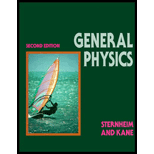
Concept explainers
(a)
The ratio of distance to the radius of a hydrogen atom.
(a)
Answer to Problem 86E
The ratio of distance to the radius of a hydrogen atom is
Explanation of Solution
Given that the charge of an electron is
Write the expression for the dipole moment.
Here,
Solve Equation (I) for
Conclusion:
Substitute
The ratio of the distance to the radius of a hydrogen atom is,
Therefore, the ratio of distance to the radius of a hydrogen atom is
(b)
The energy needed to flip the dipole.
(b)
Answer to Problem 86E
The energy needed to flip the dipole is
Explanation of Solution
Given that the electric field is
The energy required to flip the dipole can be measured by using
Here,
Conclusion:
Substitute
Therefore, the energy needed to flip the dipole is
(c)
The implication average kinetic energy of a molecule for the orientation of water molecule in the relatively strong field of
(c)
Answer to Problem 86E
The value of the
Explanation of Solution
Given that the average kinetic energy of the molecule is
Let the angle
Conclusion:
Substitute
Therefore, the value of the
Want to see more full solutions like this?
Chapter 16 Solutions
General Physics, 2nd Edition
- How many coulombs of positive charge are there in 4.00 kg of plutonium given its atomic mass is 244 and that each plutonium atom has 94 protons?arrow_forwardA water molecule consists of two hydrogen atoms bonded with one oxygen atom. The bond angle between the two hydrogen atoms is 104( (see below). Calculate the net dipole moment of a water molecule that is placed in a uniform, horizontal electric field of magnitude 2.3108N/C . (You are missing some information for solving this problem; you will need to determine what information you need, and look it up.)arrow_forwardCalculate the angular velocity of an electron orbiting a proton in the hydrogen atom, given the radius of the orbit is 0.5301010 m. You may assume that the proton is stationary and the centripetal force is supplied by Coulomb attraction.arrow_forward
- Consider the electric dipole shown in Figure P19.20. Show that the electric field at a distant point on the + x axis is Ex 4 keqa/x3.arrow_forwardA water molecule is made up of two hydrogen atoms and one oxygen atom, with a total of 10 electrons and 10 protons. The molecule is modeled as a dipole with an effective separation d = 3.9 1012 m between its positive and negative charges. What is the magnitude of the water molecules dipole moment?arrow_forwardWhy do electrostatic experiments work so poorly in hunid weather?arrow_forward
- Two thin conducting plates, each 25.0 cm on a side, are situated parallel to one another and 5.0 mm apart. If electrons are moved from one plate to the other, what is the electric field between the plates?arrow_forwardThree identical conducting spheres are fixed along a single line. The middle sphere is equidistant from the other two so that the center-to-center distance between the middle sphere and either of the other two is 0.125 m. Initially, only the middle sphere is charged, with qmiddle = +35.6 nC. The middle sphere is later connected by a conducting wire to the sphere on the left. The wire is removed and then used to connect the middle sphere to the sphere on the right. The wire is again removed. a. C What is the charge on each sphere? b. C Which sphere experiences the greatest electrostatic force? c. N What is the magnitude of that force?arrow_forwardIn a follow-up experiment, a charge of +40 pC was placed atthe center of an artificial flower at the end of a 30-cm-long stem. Beeswere observed to approach no closer than 15 cm from the center of thisflower before they flew away. This observation suggests that the smallestexternal electric field to which bees may be sensitive is closest towhich of these values? (a) 2.4 N/C; (b) 16 N/C; (c) 2.7 * 10^-10 N/C;(d) 4.8 * 10^-10 N/C.arrow_forward
- Consider a dipole consisting of charge of -27e on the left and a positive charge of +27e on the right. If the charges are separated by 2.6x10^-10 meters, in what direction does the electric field point at the position exactly between the charges?arrow_forwardWhat is the magnitude of the electric force between two electrons separated by adistance of 0.10 nm (approximately the diameter of an atom)?arrow_forwardAn (ideal) electric dipole of magnitude p = 1 × 10−6 C·m is placed ata distance a = 0.05 m away from the center of an uncharged, isolated spherical conductor of radiusR = 0.02 m. Suppose the angle formed by the dipole vector and the radial vector (the vector pointingfrom the sphere’s center to the dipole’s position) is θ = 20o. Find the (electrostatic) interaction energybetween the dipole and the charge induced on the spherical conductorarrow_forward
 Physics for Scientists and Engineers: Foundations...PhysicsISBN:9781133939146Author:Katz, Debora M.Publisher:Cengage Learning
Physics for Scientists and Engineers: Foundations...PhysicsISBN:9781133939146Author:Katz, Debora M.Publisher:Cengage Learning
 Principles of Physics: A Calculus-Based TextPhysicsISBN:9781133104261Author:Raymond A. Serway, John W. JewettPublisher:Cengage Learning
Principles of Physics: A Calculus-Based TextPhysicsISBN:9781133104261Author:Raymond A. Serway, John W. JewettPublisher:Cengage Learning


